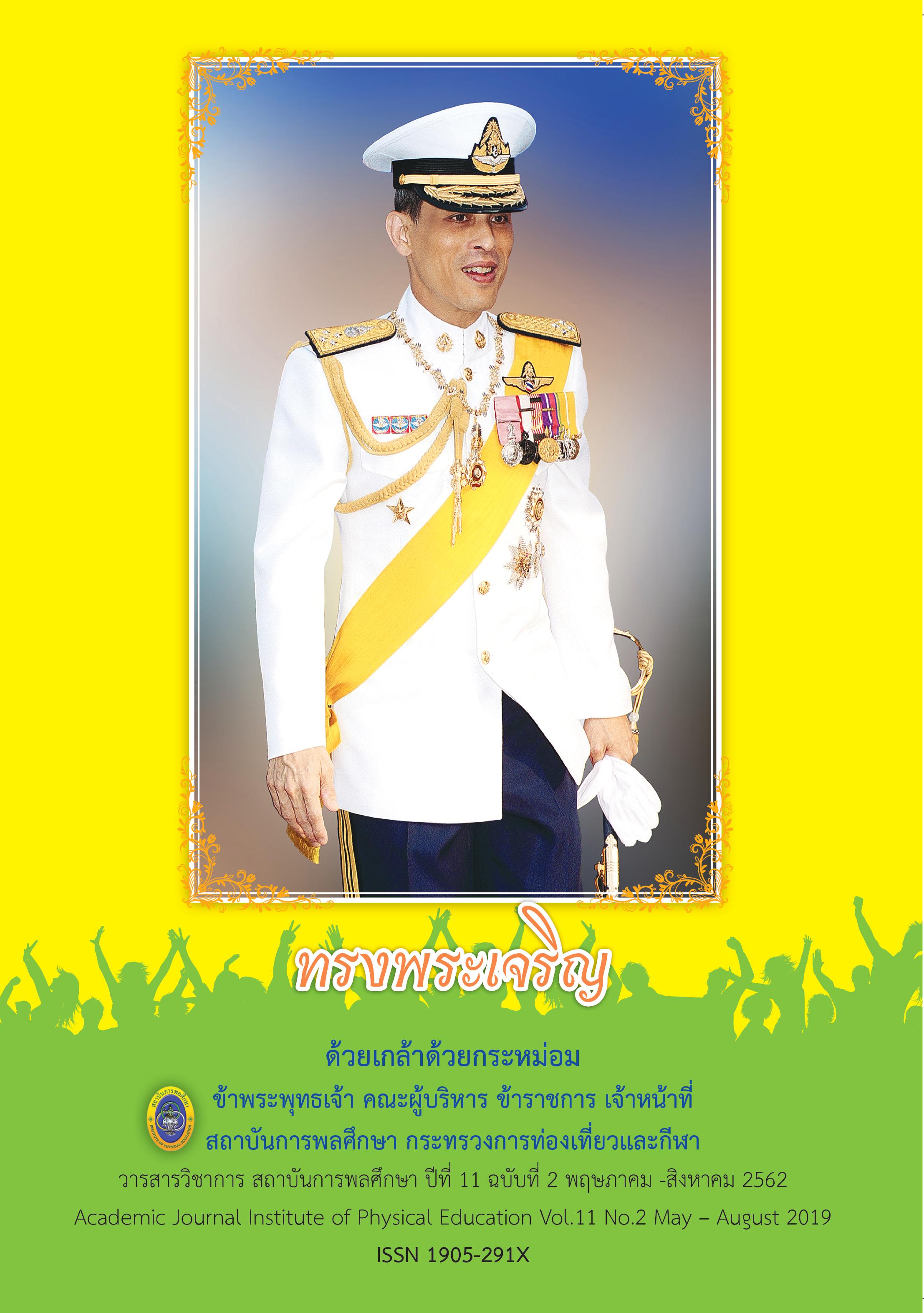FACTORS IN RELATION TO THE SUCCESS OF THAI FEMALE VOLLEYBALL PLAYERS IN THAILAND
Main Article Content
Abstract
The purposes of this research were to (1) analyze factors relating to the success of female volleyball players in Thailand and (2) create equation for predicting the success of female volleyball players in Thailand. The sample of this quantitative research which was derived from 1139 population through quota and simple random sampling, included 295 provincial representative volleyball female players, 110 regional representative volleyball female players, 45 representative volleyball female players of Thai junior national team, 30 representative volleyball female players of Thai national youth team, and 15 representative volleyball female players of Thai national team. A set of questionnaire with a 0.77 reliability coefficient was used as a tool to collect data. The statistics used in data analysis were frequency, mean, percentage, standard deviation, confirmatory factor analysis and multinomial logistic regression analysis.
The research results were as follows: 1) Factors relating to the success of Thai female volleyball players were significant at the highest level in all aspects ranking in the following descending order: leadership, plan and policy, location, materials, training and competition, potential development of sports personnel, and support and welfare, respectively. 2) Equations for predicting the success of Thai female volleyball players were divided into three types: (1 Thai female volleyball players in junior national team level compared with that of the regional level revealed that predicting factors comprising of leadership, plan and policy were the most statistically significant at a 0.05 level. (2) Thai female volleyball players in national youth team level compared with that of the regional level showed that the potential development of sports personnel was the most statistically significant factor at a 0.05 level. (3) Thai female volleyball players in national team level compared with that of the regional level indicated that training and competition was the most statistically significant factor at a 0.05 level.
Article Details
The published article is a copyright of the Academic Journal of Thailand National Sports University. The passage appeared in each article in this academic journal is a perspective of each author which is not related to the journal. Each author is required to be responsible for all components of his/her own article. If there are any mistakes, each author must be responsible for those mistakes on his/her own.
References
การกีฬาแห่งประเทศไทย. (2548). คู่มือการฝึกกีฬาวอลเลย์บอล. กรุงเทพฯ : ห้างหุ้นส่วนจำกัด อาร์ต โปรเกรส.
เกษม นครเขต. (2521). “พลศึกษา: กีฬา” วารสารสุขศึกษาพลศึกษา และสันทนาการ. ม.ป.ท.: ม.ป.พ.
กิติ คยัคคานนท์. (2530). เทคนิคการสร้างภาวะผู้นำ. (พิมพ์ครั้งที่ 2). กรุงเทพฯ: โรงพิมพ์เชษฐการพิมพ์.
เกียรติศักดิ์ สิทธิ. (2547). สภาพและปัญหาการเตรียมทีมวอลเลย์บอลชายเพื่อร่วมแข่งขันกีฬาพลศึกษา แห่งประเทศไทย ครั้งที่ 29. วิทยานิพนธ์การศึกษามหาบัณฑิต กรุงเทพฯมหาวิทยาลัยศรีนครินทรวิโรฒ.
ชัยสิทธิ์ ภาวิลาส เฉลิม ชัยวัชราภรณ์ และสุวัตร สิทธิหล่อ. (2550). วิทยาศาสตร์ การกีฬาสำหรับกีฬาเซปักตะกร้อ. การอบรมผู้ฝึกสอนกีฬาเซปักตะกร้อ (B - Licence) ครั้งที่ 2. สถาบันพัฒนากีฬาตะกร้ออาชีพนานาชาติ.
นฤพนธ์ วงค์จตุรภัทร. (2554). “พ่อแม่ช่วยลูกให้เล่นเก่งขึ้นได้อย่างไร มุมมองทางจิตวิทยาการกีฬา”. สารวิทยาศาสตร์การกีฬา, 12 (130) : 5 – 6.
ประชุม รอดประเสริฐ. (2543). นโยบายและการวางแผนหลักการและทฤษฎี. (พิมพ์ครั้งที่ 4). กรุงเทพฯ : เนติกุลการพิมพ์.
รัชนี ขวัญบุญจัน. (2547) การจัดทำแผนการพัฒนาการกีฬาสู่ความเป็นเลิศ. รายงานการวิจัย. กรุงเทพฯ : การกีฬาแห่งประเทศไทย.
วิจิตร อาวะกุล. (2533). เทคนิคมนุษยสัมพันธ์. กรุงเทพมหานคร: โอ.เอส พรินติ้งเฮาส์.
สนธยา สีละมาด. (2547). หลักการฝึกกีฬาสำหรับผู้ฝึกสอนกีฬา. กรุงเทพฯ : สำนักพิมพ์แห่งจุฬาลงกรณ์ มหาวิทยาลัย.
สมาคมวอลเลย์บอลแห่งประเทศไทย. (2555). แผนยุทธศาสตร์กีฬาวอลเลย์บอล พ.ศ. 2556 – 2560.
สืบสาย บุญวีรบุตร. (2543). จิตวิทยาการกีฬา. ชลบุรี: วิทยาลัยพลศึกษาชลบุรี.
อเนก ช้างน้อย. (2527). “การพัฒนาพลศึกษาและการกีฬาในสถาบันอุดมศึกษา.ศึกษาศาสตร์. 12(1): 179 - 187.
Chelladurai, P. (2006). Human Resource Management in Sport and Recreation. (2nded.). United States: Human Kinetics.
Cronbach, L. J. (1970). Essentials of Psychological Testing. New York: Harper & Row.


